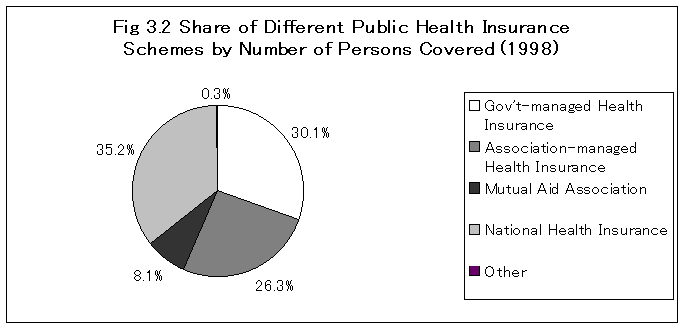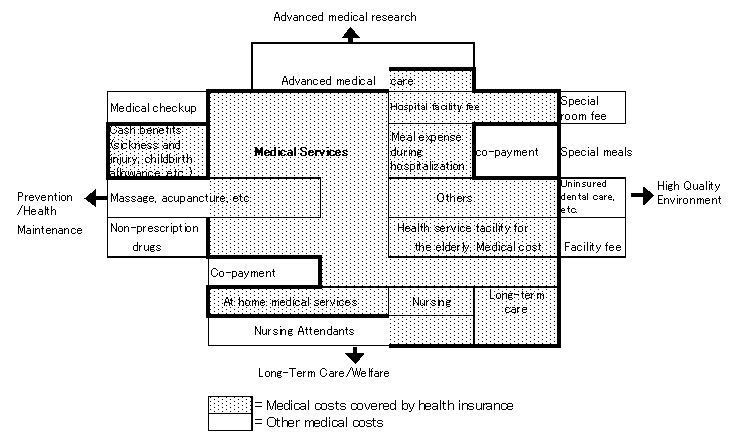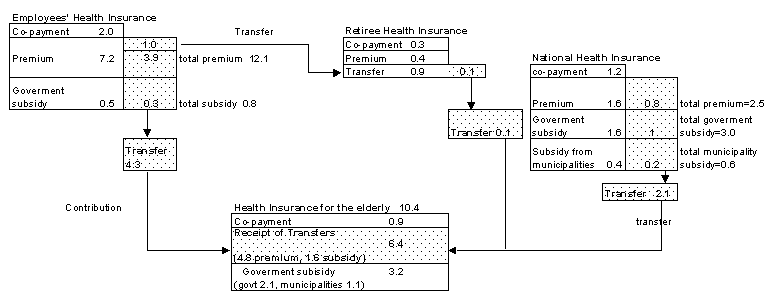
Japan's medical services are provided by public mandatory insurance program, which is run by two systems: occupation-based and region-based. The former is called Employees' Health Insurance. Employers of firms of a certain size and over and their employees form a health insurance association and thus these are called Association-managed Health Insurance. The number of the associations are more than 1,800. For those who work at smaller firms, the government provides a collective health insurance which is called Government-managed Health Insurance. In addition, special professions such as civil servants, day-laborers and seamen form separate nation-wide professional associations. Those who are not covered by the Employees' Health Insurance are required to participate in a region-based insurance, called the National Health Insurance, for which the municipalities (more than 3,000) act as the independent insurers. (See Fig 3.1)

The public health insurance with universal coverage was established in 1961 concurrently with the introduction of the universal public pension schemes. The share of each insurance system is shown in Fig. 3.2. Government-managed Health Insurance, Association-managed Health Insurance, and National Health Insurance account for about one third of the total population.

Source: MHW, "Kose Hakusho (1999)"
2.Financing of health insuranceAll the public health insurance schemes are financed by premiums, subsidy from the general budget of the government, and co-payment from patients. For the Employees' Health Insurance, the premium is a fixed percent of employee's salary, which is shared equally by the employers and the employees. For the National Health Insurance, the premium differs among local governments and is usually levied on the basis of income, property, number of insured within a household. A substantial government subsidy is given to both schemes, particularly to the National Health Insurance. For all Japanese medical insurance systems combined, the contribution by government subsidy, insurance premiums, and patient co-payment are 32.0%, 56.1%, 11.9%, respectively (1996).
3.Free to choose any medical facilityBecause Japanese health insurance systems are universal, there is no distinction between public and private hospitals from the view point of the user. In fact, users are free to choose any medical service providers without constraint in terms of hospital type, location or other factors such as having referral or not.
4.Equal coverage of services at equal priceThe coverage of health insurance and the prices of medical services are standardized by law, and thus, all persons receive the same medical service at equal price. The area covered by the insurance is shown by color in Fig. 3.3.
Fig. 3.3 Medical Services Covered by Health Insurance

As the aging of the population proceeds, the share of the health care costs for the elderly in total medical costs has increased . However, because the composition of subscribers differs among insurance schemes, some insurance schemes, such as those in the National Health Insurance have a larger number of elder subscribers than others and bear a bigger financial burden. To equalize the burden of health care costs for the elderly among insurance schemes, a new system was introduced in 1983, as described below. Under the system, the health care costs for those aged 70 and over are separated from health care system and shared by all insurance schemes.
6.Introduction of Long-Term Care InsuranceEven with such a cost-sharing system, the cost of health care for the elderly, especially of the long-term care, has become a burden on the health insurance. Recognizing the special nature of long-term care and the need to separate the long-term care from other medical services, the Government has introduced a mandatory Long-Term Care Insurance, which is to be implemented in April 2000. The new system requires new contribution from those aged over 40 and covers a variety of at-home and institutional services for those over 65 and judged as in need of long-term care.
People covered under this type of insurance are employees and their dependents. All employed persons are required to join the association, except those who are employed by private firms with less than five employees and self-employed. Depending on the occupation and size of employers, there exist several programs as described below.
(a)�@Association-managed Health Insurance
This program is operated by a health insurance association organized by large firms for their employees. Sometimes more than one firms form a single association. Currently, there are 1,815 such associations (as of March 1998).
(b)�@Government-managed Health Insurance
This is for the employees of small and medium scale firms, which cannot form health insurance associations on its own. The Government provides a collective health insurance for them, with contributions from the employers and employees.
(c)�@Day-Laborers Health Insurance
This is for day-laborers, i.e. those who are employed on a day-to-day basis, those employed for a fixed term of less than two months, those are employed for seasonal work and those who are employed at temporary workplaces. Because of their unstable relationship with employers, the Government provides a collective health insurance, for which contributions are collected on a day-to-day basis from both employers and employees.
(d)�@Other Occupation-based health insurance
This program covers all those who are not covered by the Employees' Health Insurance, i.e. self-employed, farmers, students, and so forth, including all legal foreign residents. The insurers are municipalities except for the National Health Insurance Associations, which are addressed to special professionals such as medical doctors. Retirees who previously subscribed to Employees' Health Insurance are insured under the National Health Insurance. However, the health care cost for the retirees of age 60-70 are financed by the transfer from the Employees' Health Insurance, i.e. retiree's former insurer.
The National Health Insurance is financed by government subsidy as well as insurance premiums paid on household basis. The premium can be discounted up to 60% for low-income households.
3.Health Service System for the ElderlyPreviously, health insurance for the elderly was covered by the National Health Insurance, except that they are financially dependent on their family and insured by the Employees' Health Insurance of their family. However, as a result of an increasing aging, this arrangement led to an unbearably heavy burden on the National Health Insurance. Thus, a special financial arrangement was made for those aged 70 and over, and those between 65 and 70 years old who are bed-ridden or have severe disabilities. Under this scheme, the elderly have access to health services at a nominal fee per visit (in case of out-patient) and per day (in case of hospitalization), and their health care costs are met by the subsidy from the central and local governments (30%) and the transfer of contributions from the National Health Insurance and the Employees' Health Insurance (70%). (See Fig 3.4)
Fig. 3.4 Sources of Financing in Health Insurance Schemes, 1998
(in trillions of yen )

Under the Employees' Health Insurance the insured pays 20% of cost of all care, and dependents pay 30% of cost (20% if inpatient). For both of them the maximum of co-payement is 63,600 yen a month for the same illness (35,400 yen if low-income family).
Under the National Health Insurance the insured pays 30% of medical costs. The maximum of co-payment is same as for the Employees' Health Insurance.
The co-payment for the elderly is fixed low. Outpatients pay 530 yen per visit to the same doctor or hospital up to four visits per month; for more visits free. Inpatients pay 1,200 yen per day.
As a result of aging population, the share of health care costs for the elderly has risen continuously, reaching to about 33% of all medical costs (FY 1998). Since the contribution and co-payment of the elderly are very limited, their costs are born mainly by the younger population in the health care systems. However, due to rising medical costs and decreasing premiums caused by stagnant number of employees, many insurers in the Employees' Health Insurance associations and the National Health Insurance have faced financial difficulties. 85% of the Employees' Health Insurance schemes will go into the red in FY1999, and it will be difficult for them to pay the required amount for the Health service for the Elderly, which is currently as much as 40% of their income from the premiums.
As the Long-Term Care Insurance starts in April 2000, some of the health service costs for the elderly was expected to be reduced, but the fact is that it is not the case. The reform of the entire health care system for the elderly is most needed.
2.Reform of Drug PricingDrug tariff schedule sets the official price for each medicine on the basis of the weighted average of market price. Since a medical provider can obtain medicine at a bulk price which is lower than the official price, there exists an incentive for a medical provider to prescribe more medicine, and this is one of the reasons for higher medical costs. A debate is on-going to abate this incentive and to design a new system.
3.Reform of medical fee SystemUnder the current systems of fee-for-service payments, medical providers are paid, in principle, for whatever services and medicine they provide. Thus, there is an incentive for medical providers to over-examine and over-prescribe medicine, creating a tendency to higher medical costs. In addition, there has been a gradual shift from acute to chronic diseases. This has led to a debate on a reform of the fee schedule to fixed prospective payments so that doctors are paid a fixed amount depending on the type and severity of the disease, sometimes called Diagnosis Related Groups. This system has been introduced partially to hospitals for elderly care.
4.Restructuring of medical providersIn Japan, beds for general illness compose 3/4 of total beds, while the rest goes to tuberculosis, mental illness and other special illness. Beds for general illness are used by patients of both acute and chronic conditions. This poses a problem of bed management because chronic patients occupy beds for a long period of time. Currently, it is under consideration to divide the general beds into acute and chronic uses, in order to manage beds more efficiently.
Also under consideration is to promote information sharing between doctors and patients, such as opening of medical files to the patients, informed consent practice, and more generally, protection of patients' rights.
Outline of Health Insurance system